[English] 日本語
 Yorodumi
Yorodumi- PDB-6cv5: CryoEM structure of human enterovirus D68 full particle (after in... -
+ Open data
Open data
- Basic information
Basic information
| Entry | Database: PDB / ID: 6cv5 | ||||||
|---|---|---|---|---|---|---|---|
| Title | CryoEM structure of human enterovirus D68 full particle (after incubation with low molecular weight heparin) | ||||||
 Components Components |
| ||||||
 Keywords Keywords | VIRUS / genome release / receptor | ||||||
| Function / homology |  Function and homology information Function and homology informationpicornain 2A / symbiont-mediated suppression of host mRNA export from nucleus / symbiont genome entry into host cell via pore formation in plasma membrane / picornain 3C / T=pseudo3 icosahedral viral capsid / host cell cytoplasmic vesicle membrane / viral capsid / host cell / nucleoside-triphosphate phosphatase / channel activity ...picornain 2A / symbiont-mediated suppression of host mRNA export from nucleus / symbiont genome entry into host cell via pore formation in plasma membrane / picornain 3C / T=pseudo3 icosahedral viral capsid / host cell cytoplasmic vesicle membrane / viral capsid / host cell / nucleoside-triphosphate phosphatase / channel activity / monoatomic ion transmembrane transport / RNA helicase activity / symbiont-mediated suppression of host innate immune response / endocytosis involved in viral entry into host cell / symbiont-mediated activation of host autophagy / RNA-directed RNA polymerase / cysteine-type endopeptidase activity / viral RNA genome replication / RNA-directed RNA polymerase activity / DNA-templated transcription / symbiont entry into host cell / virion attachment to host cell / host cell nucleus / structural molecule activity / ATP hydrolysis activity / proteolysis / RNA binding / zinc ion binding / ATP binding / membrane Similarity search - Function | ||||||
| Biological species |  Enterovirus D68 Enterovirus D68 | ||||||
| Method | ELECTRON MICROSCOPY / single particle reconstruction / cryo EM / Resolution: 2.79 Å | ||||||
 Authors Authors | Liu, Y. / Rossmann, M.G. | ||||||
| Funding support |  United States, 1items United States, 1items
| ||||||
 Citation Citation |  Journal: Nat Commun / Year: 2019 Journal: Nat Commun / Year: 2019Title: Bypassing pan-enterovirus host factor PLA2G16. Authors: Jim Baggen / Yue Liu / Heyrhyoung Lyoo / Arno L W van Vliet / Maryam Wahedi / Jost W de Bruin / Richard W Roberts / Pieter Overduin / Adam Meijer / Michael G Rossmann / Hendrik Jan Thibaut / ...Authors: Jim Baggen / Yue Liu / Heyrhyoung Lyoo / Arno L W van Vliet / Maryam Wahedi / Jost W de Bruin / Richard W Roberts / Pieter Overduin / Adam Meijer / Michael G Rossmann / Hendrik Jan Thibaut / Frank J M van Kuppeveld /   Abstract: Enteroviruses are a major cause of human disease. Adipose-specific phospholipase A2 (PLA2G16) was recently identified as a pan-enterovirus host factor and potential drug target. In this study, we ...Enteroviruses are a major cause of human disease. Adipose-specific phospholipase A2 (PLA2G16) was recently identified as a pan-enterovirus host factor and potential drug target. In this study, we identify a possible mechanism of PLA2G16 evasion by employing a dual glycan receptor-binding enterovirus D68 (EV-D68) strain. We previously showed that this strain does not strictly require the canonical EV-D68 receptor sialic acid. Here, we employ a haploid screen to identify sulfated glycosaminoglycans (sGAGs) as its second glycan receptor. Remarkably, engagement of sGAGs enables this virus to bypass PLA2G16. Using cryo-EM analysis, we reveal that, in contrast to sialic acid, sGAGs stimulate genome release from virions via structural changes that enlarge the putative openings for genome egress. Together, we describe an enterovirus that can bypass PLA2G16 and identify additional virion destabilization as a potential mechanism to circumvent PLA2G16. | ||||||
| History |
|
- Structure visualization
Structure visualization
| Movie |
 Movie viewer Movie viewer |
|---|---|
| Structure viewer | Molecule:  Molmil Molmil Jmol/JSmol Jmol/JSmol |
- Downloads & links
Downloads & links
- Download
Download
| PDBx/mmCIF format |  6cv5.cif.gz 6cv5.cif.gz | 174.9 KB | Display |  PDBx/mmCIF format PDBx/mmCIF format |
|---|---|---|---|---|
| PDB format |  pdb6cv5.ent.gz pdb6cv5.ent.gz | 135.4 KB | Display |  PDB format PDB format |
| PDBx/mmJSON format |  6cv5.json.gz 6cv5.json.gz | Tree view |  PDBx/mmJSON format PDBx/mmJSON format | |
| Others |  Other downloads Other downloads |
-Validation report
| Summary document |  6cv5_validation.pdf.gz 6cv5_validation.pdf.gz | 1.4 MB | Display |  wwPDB validaton report wwPDB validaton report |
|---|---|---|---|---|
| Full document |  6cv5_full_validation.pdf.gz 6cv5_full_validation.pdf.gz | 1.4 MB | Display | |
| Data in XML |  6cv5_validation.xml.gz 6cv5_validation.xml.gz | 41.3 KB | Display | |
| Data in CIF |  6cv5_validation.cif.gz 6cv5_validation.cif.gz | 61.9 KB | Display | |
| Arichive directory |  https://data.pdbj.org/pub/pdb/validation_reports/cv/6cv5 https://data.pdbj.org/pub/pdb/validation_reports/cv/6cv5 ftp://data.pdbj.org/pub/pdb/validation_reports/cv/6cv5 ftp://data.pdbj.org/pub/pdb/validation_reports/cv/6cv5 | HTTPS FTP |
-Related structure data
| Related structure data |  7636MC  7632C  7633C  7634C  7635C  7638C  6cv1C  6cv2C  6cv3C  6cv4C  6cvbC M: map data used to model this data C: citing same article ( |
|---|---|
| Similar structure data |
- Links
Links
- Assembly
Assembly
| Deposited unit | 
|
|---|---|
| 1 | x 60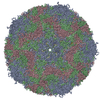
|
| 2 |
|
| 3 | x 5
|
| 4 | x 6
|
| 5 | 
|
| Symmetry | Point symmetry: (Schoenflies symbol: I (icosahedral)) |
- Components
Components
| #1: Protein | Mass: 32957.449 Da / Num. of mol.: 1 / Fragment: UNP residues 565-861 / Source method: isolated from a natural source / Source: (natural)  Enterovirus D68 / Cell line: rhabdomyosarcoma / Strain: 947 / References: UniProt: A0A0X7Z9B1 Enterovirus D68 / Cell line: rhabdomyosarcoma / Strain: 947 / References: UniProt: A0A0X7Z9B1 |
|---|---|
| #2: Protein | Mass: 27170.895 Da / Num. of mol.: 1 / Fragment: UNP residues 1-247 / Source method: isolated from a natural source / Source: (natural)  Enterovirus D68 / Cell line: rhabdomyosarcoma / Strain: 947 / References: UniProt: E9RIT6 Enterovirus D68 / Cell line: rhabdomyosarcoma / Strain: 947 / References: UniProt: E9RIT6 |
| #3: Protein | Mass: 27595.215 Da / Num. of mol.: 1 / Fragment: UNP residues 1-248 / Source method: isolated from a natural source / Source: (natural)  Enterovirus D68 / Cell line: rhabdomyosarcoma / Strain: 947 / References: UniProt: A0A097ZN88, UniProt: A0A0X7Z9B1*PLUS Enterovirus D68 / Cell line: rhabdomyosarcoma / Strain: 947 / References: UniProt: A0A097ZN88, UniProt: A0A0X7Z9B1*PLUS |
| #4: Protein | Mass: 7336.960 Da / Num. of mol.: 1 / Fragment: UNP residues 2-69 / Source method: isolated from a natural source / Source: (natural)  Enterovirus D68 / Cell line: rhabdomyosarcoma / Strain: 947 / References: UniProt: A0A0P0DH17 Enterovirus D68 / Cell line: rhabdomyosarcoma / Strain: 947 / References: UniProt: A0A0P0DH17 |
| #5: Water | ChemComp-HOH / |
-Experimental details
-Experiment
| Experiment | Method: ELECTRON MICROSCOPY / Number of used crystals: 1 |
|---|---|
| EM experiment | Aggregation state: PARTICLE / 3D reconstruction method: single particle reconstruction |
- Sample preparation
Sample preparation
| Component | Name: Enterovirus D68 / Type: VIRUS / Details: Grown in RD cells / Entity ID: #1-#4 / Source: NATURAL |
|---|---|
| Source (natural) | Organism:  Enterovirus D68 / Strain: 947 Enterovirus D68 / Strain: 947 |
| Details of virus | Empty: NO / Enveloped: NO / Isolate: STRAIN / Type: VIRION |
| Natural host | Organism: Homo sapiens |
| Buffer solution | pH: 7.2 / Details: phosphate buffer |
| Specimen | Embedding applied: NO / Shadowing applied: NO / Staining applied: NO / Vitrification applied: YES |
| Specimen support | Grid material: COPPER / Grid mesh size: 400 divisions/in. / Grid type: Homemade |
| Vitrification | Instrument: GATAN CRYOPLUNGE 3 / Cryogen name: ETHANE / Humidity: 85 % / Chamber temperature: 298 K |
- Electron microscopy imaging
Electron microscopy imaging
| Experimental equipment |  Model: Titan Krios / Image courtesy: FEI Company |
|---|---|
| Microscopy | Model: FEI TITAN KRIOS |
| Electron gun | Electron source:  FIELD EMISSION GUN / Accelerating voltage: 300 kV / Illumination mode: FLOOD BEAM FIELD EMISSION GUN / Accelerating voltage: 300 kV / Illumination mode: FLOOD BEAM |
| Electron lens | Mode: BRIGHT FIELD / Nominal magnification: 22500 X / Calibrated defocus min: 600 nm / Calibrated defocus max: 4500 nm / Cs: 2.7 mm / C2 aperture diameter: 100 µm / Alignment procedure: COMA FREE |
| Specimen holder | Cryogen: NITROGEN / Specimen holder model: FEI TITAN KRIOS AUTOGRID HOLDER |
| Image recording | Average exposure time: 7 sec. / Electron dose: 33 e/Å2 / Detector mode: SUPER-RESOLUTION / Film or detector model: GATAN K2 SUMMIT (4k x 4k) / Num. of grids imaged: 1 / Num. of real images: 872 |
| Image scans | Sampling size: 5 µm / Width: 3838 / Height: 3710 / Movie frames/image: 35 / Used frames/image: 2-35 |
- Processing
Processing
| Software |
| |||||||||||||||||||||||||||||||||||||||||||||||||||||||||||||||||
|---|---|---|---|---|---|---|---|---|---|---|---|---|---|---|---|---|---|---|---|---|---|---|---|---|---|---|---|---|---|---|---|---|---|---|---|---|---|---|---|---|---|---|---|---|---|---|---|---|---|---|---|---|---|---|---|---|---|---|---|---|---|---|---|---|---|---|
| EM software |
| |||||||||||||||||||||||||||||||||||||||||||||||||||||||||||||||||
| CTF correction | Details: On-the-fly CTF correction during 2D alignment and 3D reconstruction Type: PHASE FLIPPING AND AMPLITUDE CORRECTION | |||||||||||||||||||||||||||||||||||||||||||||||||||||||||||||||||
| Particle selection | Num. of particles selected: 18049 | |||||||||||||||||||||||||||||||||||||||||||||||||||||||||||||||||
| Symmetry | Point symmetry: I (icosahedral) | |||||||||||||||||||||||||||||||||||||||||||||||||||||||||||||||||
| 3D reconstruction | Resolution: 2.79 Å / Resolution method: FSC 0.143 CUT-OFF / Num. of particles: 5104 / Algorithm: FOURIER SPACE / Symmetry type: POINT | |||||||||||||||||||||||||||||||||||||||||||||||||||||||||||||||||
| Atomic model building | Protocol: RIGID BODY FIT / Space: REAL / Target criteria: correlation coefficient | |||||||||||||||||||||||||||||||||||||||||||||||||||||||||||||||||
| Displacement parameters | Biso max: 152.93 Å2 / Biso mean: 26.5606 Å2 / Biso min: 2 Å2 |
 Movie
Movie Controller
Controller


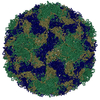

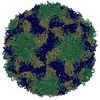
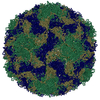
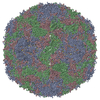

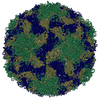
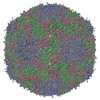
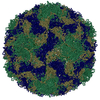
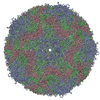
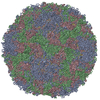
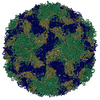
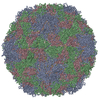
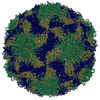
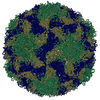
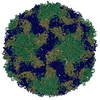
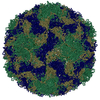

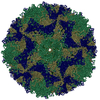
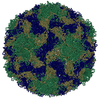
 PDBj
PDBj


